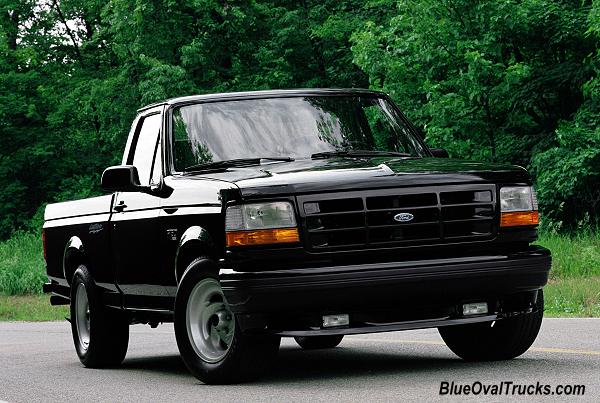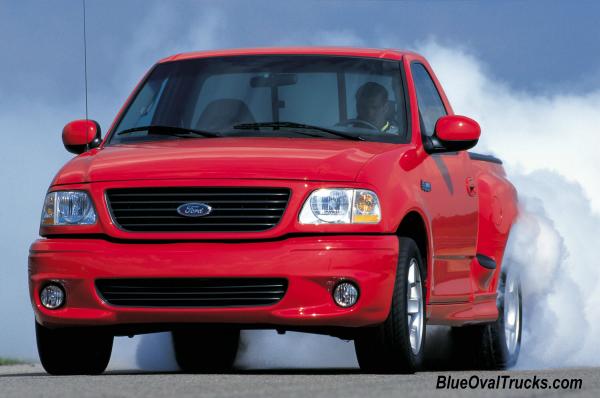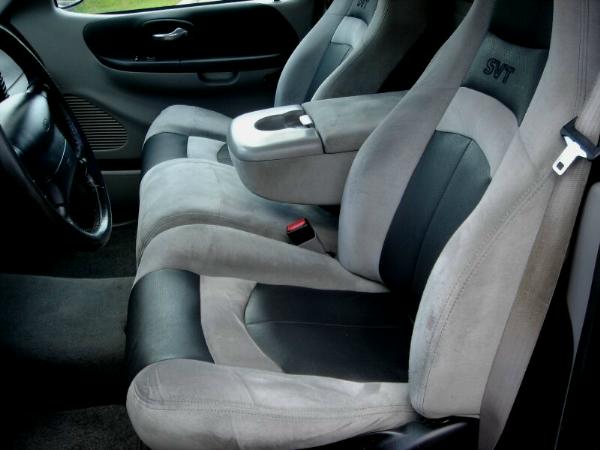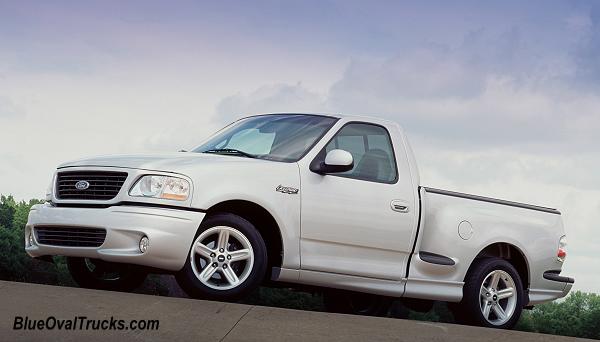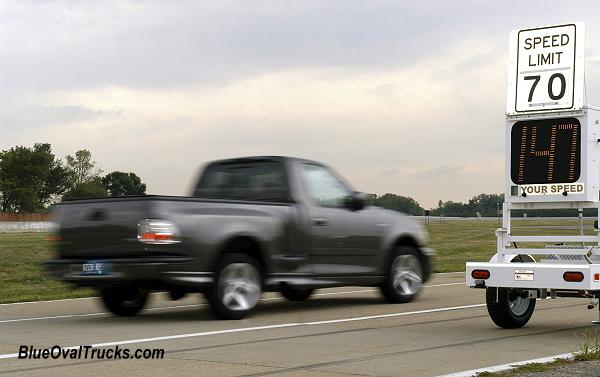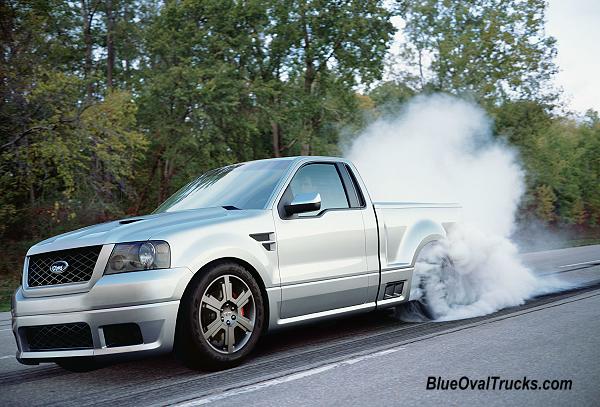1993-1995 (Generation I)
The Ford Special Vehicle Team (SVT) was conceived in 1991, when Ford senior management recognized the corporate advantages of investigating niche vehicle market opportunities. The idea was to assemble passionate driving enthusiasts within Ford and some of its key suppliers into a small, cross-functional group of engineers, product planners and marketing professionals with a common mission: create vehicles to satisfy the desires of knowledgeable, high-performance auto enthusiasts.
SVT was charged to develop and market factory high-performance “halo” vehicles that would add luster to the company’s lineup – or “Polish the Ford Oval.” To that end, the team focused on creating limited-production cars and trucks with balanced performance attributes — vehicles that stop as well as they accelerate, ride as well as they handle and, above all, are fun to drive. All vehicles that wear the SVT badge are designed and developed with four hallmarks in mind: Performance, Substance, Exclusivity and Value.
The official launch of SVT came during the 1992 Chicago Auto Show with the unveiling of the 1993 SVT Mustang Cobra and SVT F-150 Lightning. Both went on sale in February of ’93. The Lightning was originally offered in black or red. White was added for 1994 and 1995.
There were a total of 11,563 Lightning’s produced from 1993-1995. The truck was only offered as a standard cab short bed.
The first generation Lightning’s used and existing 351cid Windsor engine, but Ford engineers fitted it with high flow rate GT40 heads and used hypereutectic pistons to increase response, output and durability.
An upgraded Ford E40D automatic transmission equipped with an aluminum driveshaft was standard and the only available transmission. 4.10:1 ratio rear gears, special 17-inch aluminum wheels with Firestone Firehawk tires, unique Lightning badging, a custom front air dam with integrated fog lights, a 120 mph speedometer and unique under hood treatments including a special “Lightning” intake manifold casting all differentiated the Lightning from normal F-150s. Bucket seats with electrically-adjustable side bolsters and lumbar supports were part of the package. Suspension modifications made the truck stiffer and more responsive, and provided a 1 in front and 2.5 in rear drop in ride height, lowering the vehicle’s center of gravity and improving handling.
The 1993 Lightning had an incredible 23 product “firsts” or pilot applications, including the first true dual exhaust on an F-Series, the first bucket seats in an F-Series, the first 17-inch wheels and tires, and the first use of synthetic lubricant in Ford truck rear axles. These trucks were manufactured at Ford’s Michigan Truck Facility in Wayne, Michigan.
| Year | Engine | Power | Torque | Black Trucks | Red Trucks | White Trucks | Total Production |
|---|---|---|---|---|---|---|---|
| 1993 |
5.8 L Windsor FI V8 |
240 hp | 340 ft·lbf | 2,691 | 2,585 | N/A | 5,276 |
| 1994 | 1,382 | 1,165 | 1,460 | 4,007 | |||
| 1995 | 824 | 695 | 761 | 2,280 | |||
| Total: | 11,563 | ||||||
(2001 Ford F-150 Lightning)
1999-2004 (Generation II)
For 2001, the truck receive several upgrades. The air intake manifold offers improved airflow, to yield 20 additional horsepower to reach 380hp. Torque also improves to 450 ft-lbs. Resulting 0-60 times have dropped to 5.8 seconds. The truck features an aluminum driveshaft, and a 3.73:1 rear axle ratio. Mono-tube Bilstein shocks improve handling, while the passenger side shock is repositioned in front of the axle to reduce axle-wrap.
Goodyear stepped up with unique Eagle F1-GS tires with a new rubber compound. The wheels are also new. Unique headlamps, corner lamps, fog lamps and tail lamps with a modern clear front lens have been introduced. The roof-mounted third brake lamp is now illuminated by a sindle row of LED. Upper and lower grill inserts get a new design.
The upgraded Lightning reflected the high-mark for Lightning production. Subsequent years retained many of the same features while demand lacked until it was dropped in 2004.
Ford re-introduced the Lightning in 1999 based on the 1997 body style. The new truck features a 5.4L Triton V8 with an Eaton supercharger and produced 360 horsepower and 440 ft·lb of torque. The engine was backed by a 4R100 automatic transmission that sent power to the 3.55 gears in the rear end. The Lightning featured specialized 18″ wheels mounted with Goodyear Eagle F1 295/45ZR-18 tires. The Lightning’s suspension system was one inch lower in the front and two inches lower in the rear than the standard F-150. Monroe shocks were used from 1999-2001 then replaced with Bilstein shocks from 2002-2004.
In the 2001 Model Year, the engine design was slightly altered to produce 380 horsepower @ 4,750 rpm and 450 ft·lb of torque @ 3,250 rpm. The intercooler was redesigned to resolve a leaking problem that was addressed as a recall in earlier models. Another engine revision came in the 2003 Model Year when the lack of sufficient threads for spark plugs, was addressed and fixed, although “piston slap”, a mild knocking noise while the engine is cold, was still present. At the other end of the drivetrain, the final drive ratio was shortened to 3.73:1 in 2001. Also, in 2001 the drive shaft was increased in size to a 4.5-inch (110 mm) aluminum unit, from the previous 3.5-inch (89 mm) steel unit. The specially developed 295/45ZR-18 Goodyear Eagle F1-GS unidirectional tires were upgraded utilizing a new generation F1 GS rubber compound, improving the tires’ grip. With these engine and drivetrain revisions, Car and Driver magazine drove a lightning from zero to 60 mph in 5.2 seconds.
28,124 Lightning’s were produced from 1999 to 2004. The Lightning remained a standard cab and was only offered with a step-side bed. It was initially offered in just Bright Red, Black, and White paint colors. The 2000 Model Year brought the addition of the Silver color to the lineup. In 2002, True Blue, a very dark blue, was offered, but replaced with a lighter Sonic Blue in 2003. The 2003 Model Year also saw the introduction of the Dark Shadow Grey color.
These trucks were manufactured at Ford’s Ontario Truck Facility in Oakville, Ontario until its closure.
(2004 Ford F-150 Lightning)
| Year | Engine | Power | Torque | Production |
|---|---|---|---|---|
| 1999 |
5.4 L Supercharged Triton V8 |
360 hp |
440 ft·lb |
4,000 |
| 2000 | 4,966 | |||
| 2001 |
380 hp |
450 ft·lb |
6,381 | |
| 2002 | 4,726 | |||
| 2003 | 4,270 | |||
| 2004 | 3,781 | |||
| Total: | 28,124 | |||
Worlds Fastest Production Pickup
In August 2003, the 2003 SVT Lightning was certified as the Worlds Fastest Production Pickup. Click HERE for more details.
The End of Production
According to Ford Performance Vehicle Dynamics Technical Specialist Eric Zinkosky, the F-150 simply grew too large in the 2000’s for it to be turned into a proper street performance machine practically.
“In about 2006, we started looking at a performance truck off the new chassis,” Zinkosky told Motor Authority. “The truck had grown to be very big. When we looked at what it took to make that a better performing [SVT Lightning], it was a lot of power, it was a lot of tire, it was a lot of brake. In our mind, that became a huge challenge.”
Of particular concern was the braking. Zinkosky said that in order to haul a big truck like the 2004 Ford F-150 to a stop quickly on a road course, massive, heavy 6-piston calipers would have been required. In the end, too much bulky equipment would have been required to make a new SVT Lightning work.
On a happier note, it was some years later that Jamal Hameedi – now Ford Performance Vehicle Chief Engineer – came up with the idea for an off-road performance machine, which would go on to be named the “SVT Raptor.” Mr. Hameedi “took a look at what people were doing with their F-150s,” said Zinkosky. “Driving them down the road, and paying some upfitter eight or ten thousand dollars to put some bigger tires on it, and a lift kit, and the Fox Shox. We realized there was a place where the OEMs weren’t doing anything, and that was this performance off-road truck right out of the dealership.”
2005 Ford SVT Lightning F-150 Concept
Although the Lightning is currently being produced, Ford hasn’t completely forgotten about it.
Ford built a SVT F-150 Lightning concept based on the new 2004 F-150 body style. It made its debuted at the 2003 North American International Auto Show in Detroit. For more information, click HERE.
Ford Lightning Year Differences
2000
- Silver Metallic Added To Paint Options
2001
- Lower Intake Redesigned
- Air Inlet Size Increased
- Power Increased To 380hp & 450lb/tq
- 3.55 Axle Ratio Upgraded To 3.73 Ratio
- Driveshaft Size Increased From 3.5″ To 4.5″
2002
- True Blue Added To Paint Options
- Locking Lug Nuts Become Standard On All Lightnings
- Keyless Entry Becomes Standard On All Lightnings
2003
- Revised Cylinder Heads To Address Spark Plug Blowout Problems
- Sonic Blue Replaces True Blue
- Dark Shadow Grey Introduced As A Paint Option
- Redesigned 5 Spoke Cast Aluminum Wheels
- Steering System Is Returned
- Payload Increased From 800 lbs to 1350 lbs
Ford Lightning Suspension
Front
- Upper/Lower A Arms
- SVT Coil Springs
- Billstein Shocks
- 31mm Stabilizer Bar
- Lowered 1.5″ Front
Rear
- Staggered Billstein Gas Charged Shocks
- 5 Leaf Spring Setup
- 23mm Stabilizer Bar
- Lowered 2.0″ Rear
Ford Lightning Interior
- 60/40 Split Cloth Seats W/ Leather Inserts
- Fold Up Center Console
- SVT Logo Embroidered On Backrest Of Seats
- White Face Gauge Cluster
Ford Lightning Brakes
Front: 12.1″ Vented Rotors With Twin Piston Calipers
Rear: 13.1″ Vented Rotors With Single Piston Calipers
Ford Lightning Engine Specs (99-04)
| Engine: | Ford 5.4L V-8 w/ Forged Internals |
| Supercharger: | Eaton Gen IV Supercharger, Water-To-Air Intercooler |
| Displacement: | 5.4 Liters, 330 Cubic Inches |
| Bore x Stroke: | 3.40″ x 4.10″ (90mm x 105.6mm) |
| Compression Ratio: | 8.4:1 |
| Cylinder Heads | • Aluminum Heads, 2 Valves Per Cylinder. |
| • 44.5mm Diameter Intake Valve | |
| • 36.0mm Diameter Intake Valve | |
| Pistons: | Forged Steel |
| Rods: | Sinter Forged Allow Connecting Rods |
| Crankshaft: | Forged Steel |
| Exhaust: | Tuned Cast Iron Exhaust Manifold |
| Redline: | 5,250 RPM, Fuel Shutoff At 5,400 RPM |
| Horsepower: | • 360 hp @ 4,750 rpm (1999 & 2000 model years) |
| • 380 hp @ 4,750 rpm (2001 – 2004 model years) | |
| Torque: | • 440 lb-ft @ 3,250 rpm (1999 & 2000 model years) |
| • 450 lb-ft @ 3,250 rpm (2001 – 2004 model years) |
Ford Lightning Production Numbers (1999-2004)
| 1999 | 2000 | 2001 | 2002 | 2003 | 2004 | |
|---|---|---|---|---|---|---|
| Black | 1,601 | 1,596 | 1,908 | 1,198 | 1,036 | 843 |
| Bright Red | 1,533 | 1,405 | 1,722 | 1,086 | 735 | 648 |
| Oxford White | 866 | 928 | 1,170 | 294 | 606 | 428 |
| Silver Metallic | N/A | 1,037 | 1,581 | 1,018 | N/A | 618 |
| True Blue | N/A | N/A | N/A | 1,130 | N/A | N/A |
| Dark Shadow Grey | N/A | N/A | N/A | N/A | 1,170 | 648 |
| Sonic Blue | N/A | N/A | N/A | N/A | 723 | 596 |
| Total | 4000 | 4966 | 6381 | 4726 | 4270 | 3781 |

